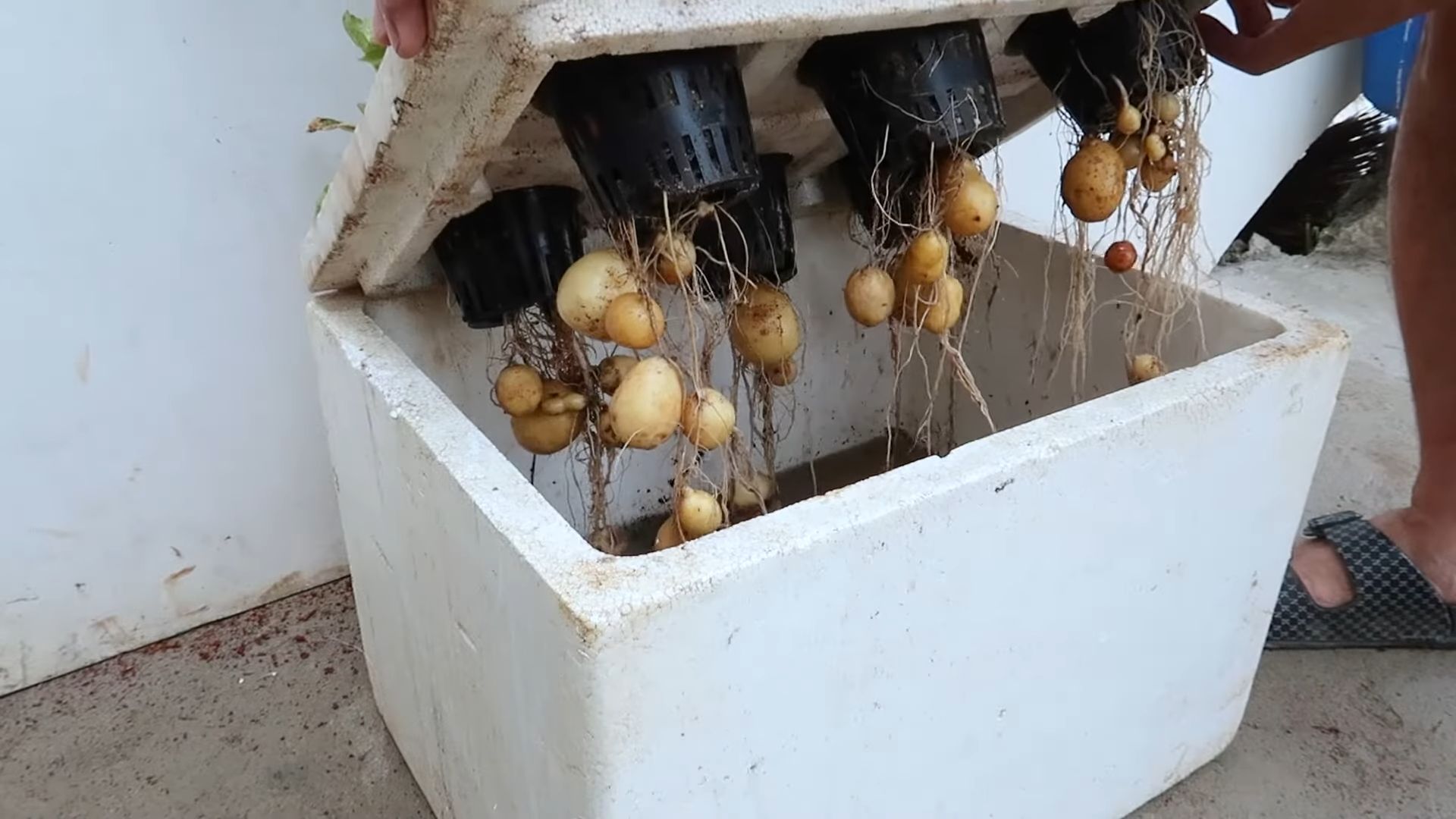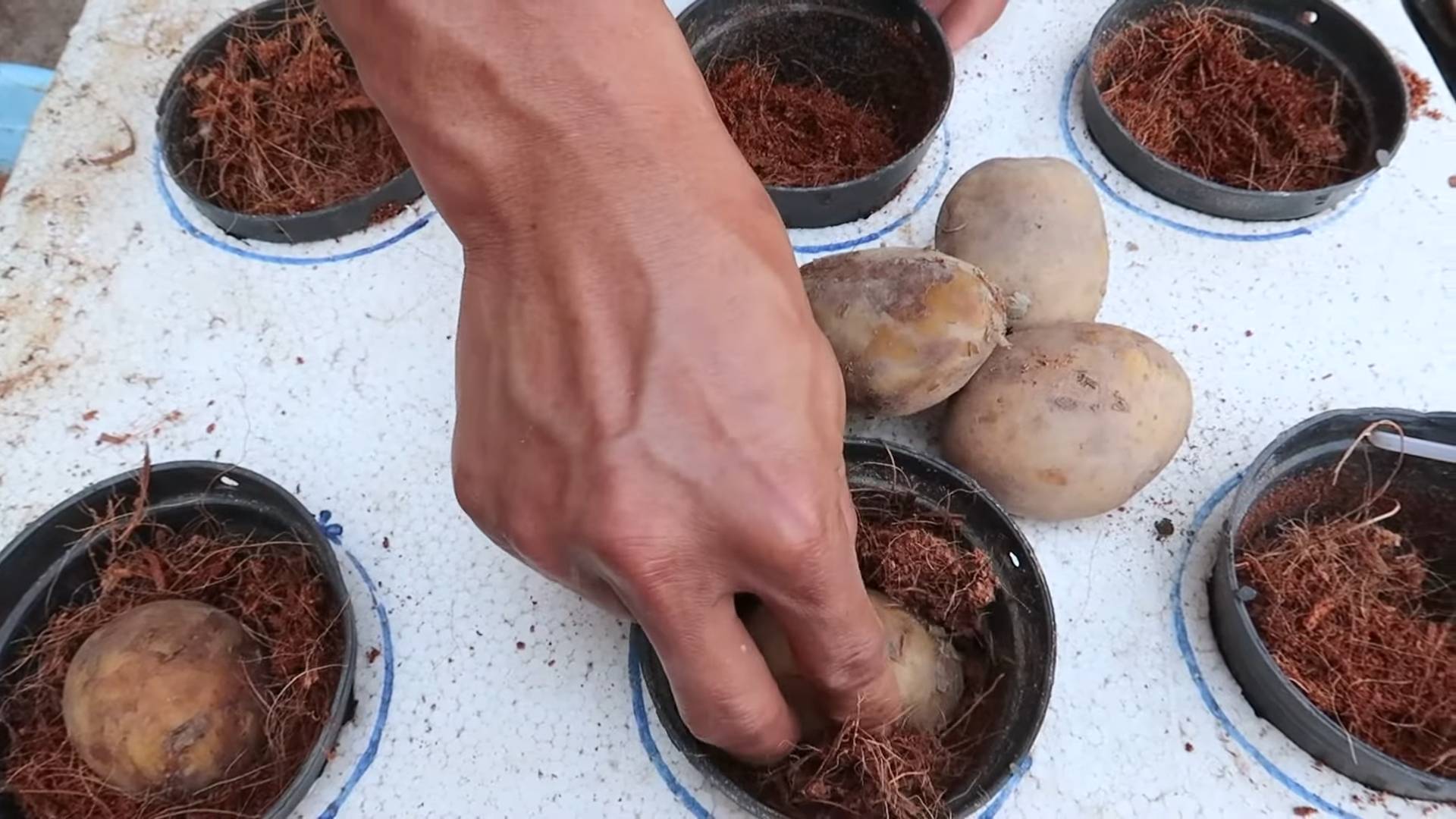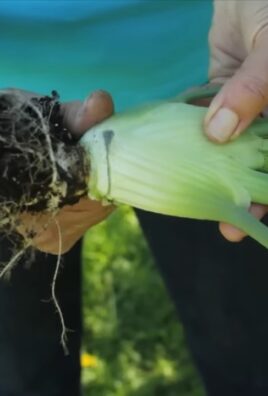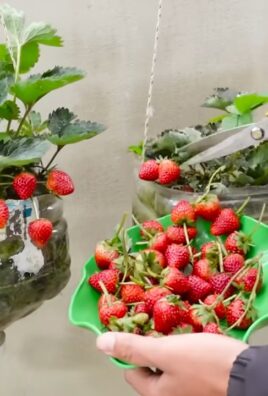Growing Potatoes in Containers: Imagine harvesting a bounty of fresh, homegrown potatoes right from your patio or balcony! No sprawling garden needed. I’m so excited to share this simple yet incredibly rewarding DIY project with you. For centuries, potatoes have been a staple food source, playing a crucial role in feeding communities worldwide. From the Inca civilization in the Andes to the humble family farms of today, the potato’s versatility and nutritional value are undeniable.
But what if you lack the space for a traditional potato patch? That’s where the magic of container gardening comes in! Growing Potatoes in Containers is the perfect solution for urban dwellers, apartment residents, or anyone with limited garden space. This DIY trick not only allows you to enjoy the taste of freshly dug potatoes, but it also gives you complete control over the growing environment, minimizing pests and diseases. Plus, it’s a fantastic way to get your hands dirty and connect with nature, even in the heart of the city. I’ll guide you through each step, from choosing the right container and soil to harvesting your delicious potato crop. Get ready to experience the joy of homegrown potatoes, no matter where you live!

Growing Potatoes in Containers: A Bountiful Harvest on Your Patio!
Hey there, fellow gardening enthusiasts! I’m so excited to share my tried-and-true method for growing potatoes in containers. Forget needing acres of farmland – you can enjoy fresh, homegrown potatoes even if you only have a small balcony or patio. This method is super rewarding, and trust me, there’s nothing quite like digging into a container and unearthing your own potato treasure!
What You’ll Need: The Potato Growing Arsenal
Before we dive in, let’s gather our supplies. Here’s a checklist to make sure you’re fully equipped for potato-growing success:
* A Large Container: This is crucial! Aim for a container that’s at least 15 gallons in size. The bigger, the better, as it gives the potatoes plenty of room to grow. Think large buckets, trash cans (with drainage holes!), or even grow bags.
* Seed Potatoes: These aren’t seeds, but rather potatoes specifically grown for planting. You can find them at your local garden center or online. Choose a variety you love to eat!
* Well-Draining Potting Mix: This is key to preventing root rot. Avoid using garden soil, as it can become compacted in containers.
* Water: Obvious, but essential!
* Fertilizer (Optional): A balanced, slow-release fertilizer can give your potatoes an extra boost.
* Gardening Gloves: To keep your hands clean and protected.
* Trowel or Small Shovel: For planting and adding soil.
* Mulch (Optional): Straw or wood chips can help retain moisture and suppress weeds.
Choosing the Right Seed Potatoes: A Potato Primer
Not all potatoes are created equal when it comes to planting. You need “seed potatoes,” which are specifically grown for this purpose. Here’s what to look for:
* Certified Seed Potatoes: These are disease-free and guaranteed to sprout.
* Variety: Consider what kind of potatoes you enjoy eating. Russets are great for baking, Yukon Golds are perfect for roasting, and red potatoes are delicious boiled or in salads.
* Size: Smaller seed potatoes can be planted whole, while larger ones can be cut into pieces. Each piece should have at least one or two “eyes” (those little buds that sprout).
Preparing Your Seed Potatoes: Sprouting for Success
This step is optional, but I highly recommend it! “Chitting,” or pre-sprouting, your seed potatoes gives them a head start and can result in an earlier harvest.
1. A Few Weeks Before Planting: Place your seed potatoes in a cool, bright location (but not direct sunlight). An egg carton or a tray works well.
2. Encourage Sprouting: Over the next few weeks, you’ll notice small, green sprouts (eyes) emerging from the potatoes.
3. Ready to Plant: Once the sprouts are about an inch long, your seed potatoes are ready to go!
Planting Your Potatoes: The Step-by-Step Guide
Alright, let’s get our hands dirty! Here’s how to plant your potatoes in containers:
1. Prepare the Container: Make sure your container has adequate drainage holes. If not, drill some!
2. Add Initial Soil Layer: Fill the bottom of the container with about 4-6 inches of potting mix.
3. Plant the Seed Potatoes: Place the seed potatoes on top of the soil, with the sprouts facing upwards. If you cut your seed potatoes, allow the cut surfaces to callous over for a day or two before planting to prevent rot. Space them evenly if you’re planting multiple potatoes in one container.
4. Cover with Soil: Cover the seed potatoes with another 4-6 inches of potting mix.
5. Water Thoroughly: Water the container well until water drains out of the bottom.
“Hilling” Your Potatoes: The Secret to a Bigger Harvest
This is where the magic happens! “Hilling” is the process of adding more soil to the container as the potato plants grow. This encourages the plants to produce more potatoes along the buried stem.
1. Wait for Growth: Once the potato plants have grown about 6-8 inches tall, it’s time to hill.
2. Add More Soil: Add enough potting mix to cover the lower part of the stems, leaving only the top few inches exposed.
3. Repeat the Process: Continue hilling every few weeks as the plants grow, until the container is almost full.
Caring for Your Potato Plants: Sunshine, Water, and Love
Now that your potatoes are planted, it’s time to provide them with the care they need to thrive.
1. Sunlight: Potatoes need at least 6-8 hours of sunlight per day. Place your container in a sunny location.
2. Watering: Water regularly, especially during hot, dry weather. The soil should be consistently moist, but not waterlogged. Check the soil moisture by sticking your finger into the soil – if it feels dry an inch or two down, it’s time to water.
3. Fertilizing (Optional): If you’re using fertilizer, follow the instructions on the package. A balanced, slow-release fertilizer is a good choice.
4. Pest Control: Keep an eye out for pests like aphids or potato beetles. If you spot any, you can try hand-picking them off or using an organic insecticide.
5. Monitor for Diseases: Potato blight can be a problem, especially in humid climates. Look for brown spots on the leaves. If you suspect blight, remove the affected leaves and consider using a fungicide.
Harvesting Your Potatoes: The Grand Finale!
The moment we’ve all been waiting for! Here’s how to know when your potatoes are ready to harvest:
1. Timing: Depending on the variety, potatoes typically take 70-100 days to mature.
2. Signs of Maturity: The potato plants will start to flower, and the foliage will begin to turn yellow and die back.
3. Gentle Digging: Stop watering when the foliage starts to die back. After a week or two, it’s time to harvest! Carefully dig into the container with your hands or a trowel, and gently unearth your potato treasure.
4. Enjoy Your Harvest: Brush off the excess soil and admire your homegrown potatoes!
Troubleshooting: Common Potato Problems and Solutions
Even with the best care, you might encounter a few challenges along the way. Here are some common problems and how to address them:
* Yellowing Leaves: This could be due to overwatering, underwatering, nutrient deficiency, or disease. Check the soil moisture, fertilize if needed, and inspect for signs of disease.
* Small Potatoes: This could be caused by insufficient sunlight, overcrowding, or lack of nutrients. Make sure your plants are getting enough sunlight, thin out the plants if necessary, and fertilize regularly.
* Potato Scab: This is a common fungal disease that causes rough, scabby patches on the potato skin. It’s usually not a serious problem, but it can affect the appearance of the potatoes. To prevent scab, avoid overwatering and maintain a slightly acidic soil pH.
* Pests: Aphids, potato beetles, and other pests can damage potato plants. Hand-pick them off or use an organic insecticide.
Tips and Tricks for Potato Growing Success
Here are a few extra tips to help you get the most out of your container potato garden:
* Rotate Your Crops: Avoid planting potatoes in the same container year after year, as this can deplete the soil of nutrients and increase the risk of disease.
* Use a Dark-Colored Container: Dark-colored containers absorb more heat, which can help warm the soil and promote faster growth.
* Add Compost: Incorporating compost into your potting mix will provide your potatoes with essential nutrients and improve drainage.
* Don’t Overwater: Overwatering can lead to root rot and other problems. Water only when the soil feels dry to the touch.
* Be Patient: Growing potatoes takes time and patience. Don’t get discouraged if you don’t see results immediately. Just keep providing your plants with the care they need, and you’ll be rewarded with a bountiful harvest.
Storing Your Harvest: Keeping Your Potatoes Fresh
Once you’ve harvested your potatoes, it’s important to store them properly to keep them fresh for as long as possible.
1. Curing: After harvesting, let the potatoes cure for a week or two in a cool, dark, and well-ventilated place. This will help the skins to harden and prevent spoilage.
2. Storage: Store the cured potatoes in a cool, dark, and dry place, such as a root cellar or a basement. The ideal temperature is between 40-50

Conclusion
So, there you have it! Growing potatoes in containers isn’t just a gardening trend; it’s a genuinely rewarding and accessible way to cultivate your own fresh produce, even if you’re short on space. We’ve walked through the entire process, from selecting the right container and seed potatoes to nurturing your plants and harvesting your bounty. The beauty of this method lies in its simplicity and adaptability. You don’t need acres of land or specialized equipment to enjoy the satisfaction of digging up your own homegrown potatoes.
Why is this DIY trick a must-try? Because it empowers you to take control of your food source, connect with nature, and enjoy the unparalleled flavor of freshly harvested potatoes. Store-bought potatoes simply can’t compare to the taste and texture of those you’ve nurtured yourself. Plus, it’s a fantastic learning experience for gardeners of all levels, offering insights into plant growth and the magic of turning a small seed potato into a substantial harvest.
But the fun doesn’t stop there! Feel free to experiment with different potato varieties. Russets are classic for baking and frying, while Yukon Golds offer a creamy texture perfect for mashed potatoes. Red potatoes are excellent for boiling and salads. Try a mix of varieties in different containers to add variety to your harvest. You can also experiment with different soil amendments. Adding compost or well-rotted manure can boost nutrient levels and improve drainage. Consider companion planting, too. Marigolds can deter pests, while basil can enhance the flavor of your potatoes.
For those looking to maximize their yield, consider using a larger container or even a grow bag specifically designed for potatoes. These bags often have access flaps that allow you to harvest potatoes from the bottom without disturbing the entire plant. Another variation is to try “stacking” your potatoes. As the potato plant grows, continue to add soil, burying more of the stem. This encourages the plant to produce more potatoes along the buried stem, potentially increasing your harvest significantly.
Ultimately, the best way to learn is by doing. Don’t be afraid to get your hands dirty and experiment. Each growing season will bring new insights and opportunities to refine your technique. The joy of harvesting your own potatoes is well worth the effort.
We wholeheartedly encourage you to give this DIY trick a try. It’s a fun, educational, and rewarding experience that will connect you with nature and provide you with delicious, homegrown potatoes. And most importantly, we want to hear about your experience! Share your photos, tips, and challenges in the comments below. Let’s create a community of container potato growers and learn from each other. Tell us what varieties you tried, what challenges you faced, and what successes you celebrated. Your insights can help others embark on their own potato-growing adventures. So, grab a container, some seed potatoes, and get ready to experience the joy of growing your own food! This method of growing potatoes in containers is a game changer for small space gardening.
Frequently Asked Questions (FAQ)
What size container is best for growing potatoes?
The ideal container size depends on the potato variety and how many potatoes you want to grow in each container. Generally, a container that is at least 10 gallons in size is recommended. A 20-gallon container or larger is even better, especially for larger potato varieties like Russets. The container should be at least 12 inches deep and 12 inches in diameter to allow the potatoes to develop properly. Grow bags specifically designed for potatoes are also a great option, as they often have access flaps for easy harvesting.
What type of soil should I use for growing potatoes in containers?
Potatoes need well-draining soil that is rich in organic matter. A good potting mix is essential. Avoid using garden soil, as it can be too heavy and may not drain well in a container. A mix of equal parts potting soil, compost, and perlite or vermiculite is ideal. The compost provides nutrients, while the perlite or vermiculite improves drainage and aeration. You can also add a slow-release fertilizer to the soil mix to provide a steady supply of nutrients throughout the growing season.
How often should I water my potato plants in containers?
Watering frequency depends on the weather, the size of the container, and the type of soil you’re using. Generally, you should water your potato plants when the top inch of soil feels dry to the touch. Water deeply until water drains out of the bottom of the container. Avoid overwatering, as this can lead to root rot. During hot, dry weather, you may need to water your plants daily. Check the soil moisture regularly and adjust your watering schedule accordingly.
How much sunlight do potato plants need?
Potato plants need at least six hours of direct sunlight per day to thrive. Choose a location for your containers that receives plenty of sunlight. If you live in a very hot climate, you may need to provide some afternoon shade to prevent the plants from overheating. If you don’t have a sunny spot, you can use grow lights to supplement the sunlight.
When and how should I fertilize my potato plants?
Potatoes are heavy feeders and benefit from regular fertilization. Start by incorporating a slow-release fertilizer into the soil mix when you plant your seed potatoes. Then, fertilize every 2-3 weeks with a balanced liquid fertilizer, such as a 10-10-10 or 20-20-20 formula. Follow the instructions on the fertilizer label for proper application rates. You can also use organic fertilizers, such as compost tea or fish emulsion. Avoid over-fertilizing, as this can lead to excessive foliage growth and fewer potatoes.
How do I know when my potatoes are ready to harvest?
The timing of your potato harvest depends on the variety you’re growing and when you planted them. Generally, you can start harvesting “new potatoes” (small, immature potatoes) about 2-3 weeks after the plants flower. To harvest new potatoes, carefully dig around the edges of the container and remove a few potatoes. For mature potatoes, wait until the foliage starts to die back and turn yellow or brown. This usually happens about 80-100 days after planting. Once the foliage has died back, stop watering the plants and let the potatoes cure in the soil for a week or two before harvesting.
What are some common pests and diseases that affect potato plants?
Some common pests that affect potato plants include aphids, potato beetles, and flea beetles. You can control these pests by handpicking them off the plants, using insecticidal soap, or applying neem oil. Common diseases that affect potato plants include early blight, late blight, and potato scab. To prevent these diseases, choose disease-resistant potato varieties, provide good air circulation, and avoid overwatering. If you notice signs of disease, remove the affected foliage immediately and treat the plants with a fungicide.
Can I reuse the soil from my potato containers?
Yes, you can reuse the soil from your potato containers, but it’s important to amend it with fresh compost and fertilizer before planting again. Potatoes are heavy feeders and deplete the soil of nutrients. Amending the soil will replenish the nutrients and improve its structure. You should also check the soil for any signs of pests or diseases and treat it accordingly before reusing it. Consider rotating your crops and planting a different type of vegetable in the container the following season to help prevent soilborne diseases.
What if my potato plants are not producing any potatoes?
There are several reasons why your potato plants might not be producing potatoes. Some common causes include:
* **Insufficient sunlight:** Potatoes need at least six hours of direct sunlight per day.
* **Poor soil:** Potatoes need well-draining soil that is rich in organic matter.
* **Overwatering or underwatering:** Potatoes need consistent moisture, but avoid overwatering.
* **Insufficient fertilization:** Potatoes are heavy feeders and need regular fertilization.
* **High temperatures:** Potatoes prefer cooler temperatures and may not produce well in hot weather.
* **Disease or pests:** Check your plants for signs of disease or pests and treat them accordingly.
* **Incorrect planting depth:** Make sure you plant your seed potatoes at the correct depth (about 4-6 inches).
By addressing these potential issues, you can improve your chances of a successful potato harvest.




Leave a Comment